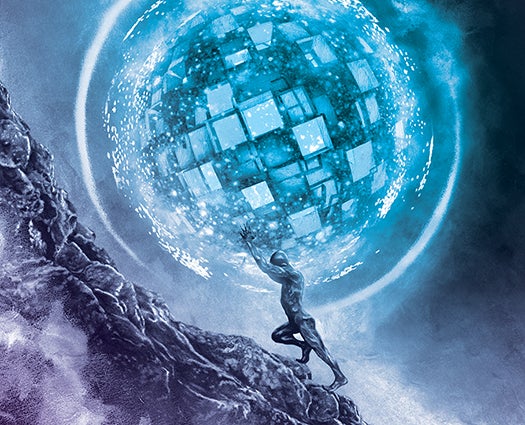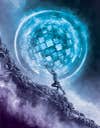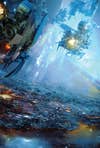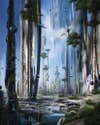Today’s Best Science Fiction Writers Imagine The Future
Predictions for how we will live and work—on Earth or in space—in the decades and centuries to come


Featured Artist: John Picacio
Hover over the bold words to see the real science behind the stories.
* * *
Scott Lynch
Volunteer firefighter Scott Lynch’s next book, The Republic Of Thieves, will hit shelves in October.
Pickle-jar technology hasn’t moved an inch in nearly three hundred years, and the cap on the jar in my hands won’t move either. The kids find it hilarious, and their fingers fly above the table as they sketch ghostly images for my benefit. My visual augments display their bright illusions in the air around me—there’s the framework of an unlikely Rube Goldberg device, along with a caricature of me caught in the grip of a huge anthropomorphic pickle jar about to twist my head off.
I grin and fire back with a double nod of my head, the signal for the house’s backbone computer to upload the week’s chore schedule to their visual augments. While they flick their eyes over the words of Parental Writ (invisible to me), I finally manage to pop the jar open. A satisfying scent of brine and mustard fills the air.
Dinner is classic American comfort food from my childhood: tomato salad, garlic naan, flash-fried wasabi chicken. The pickled cucumbers, bell peppers, and okra are from our garden, laid down in rows beside the solar tarps.
The backbone comp banishes the light sketches and seals the family’s network connections behind emergency-only courtesy walls. The outside world goes away for the day’s big formal meal, and the assorted information scrolls and data overlays behind everyone’s eyes begin to unroll gibberish. For those networked since toddlerhood, total disconnection is anything but restful, so the backbone comp temporarily supplies meaningless data that can be ignored. Enwombed in soothing white information, I smile and pass the pickle jar around.
* * *
Nancy Kress
Nancy Kress lives in Seattle. Her book After the Fall, Before the Fall, During The Fall won the 2012 Nebula for Best Novella
The monitor alarm woke me at 5 a.m.: problem in a desalinization plant supplying fresh water to New York. The robocrew couldn’t repair it, and I couldn’t fix it remotely. Groggily, cursing the AI that is always promised but never quite arrives, I boarded the maglev train.
It was crowded with people going to the floating-pavilion beaches over lower Manhattan, with all its crafts, hologram entertainments, musicians, specialty cooks, sex workers, and VR parlors. The three-day workweek gave everybody so much free time that half of all jobs are leisure-related—no other way to create full employment. My grandfather hated the Uniform Wage Act, which enforces equal wages for everybody so that even the CEO of Asteroid Mining makes the same salary as I do. I used to tell Grandpa, “Would a revolution have been better? Because that’s what we’d have got if we didn’t restructure the economy and curtail population growth.” He could never see it, but the new system works.
The desalinization plant contained only bots: operations bots, cleaning bots, repair bots, security bots, all built atom-by-atom with nanotech. I was the first human on-site in three months. After I found and fixed the software problem, I stopped at a black-market place to buy my daughter a genemod pupcat. Technically illegal—but so cute! When it barked, its implanted software translated the bark into words: “Pet me!” Half a week’s salary, but Cassie will love it. After all, what’s money for?

Featured Artist: David Palumbo
* * *
Ian Tregillis
Ian Tregillis consorts with scientists, writers, and other disreputable types. His novel Necessary Evil came out in April.
Join the NERE revolution! Clean water is a fundamental human need that unites our far-flung species: those of us who remain on Earth, those colonizing the steroid belt, and even those en route to the stars. But the supply of clean water is not limitless. This is as true on Mars, Ceres, and Tau Ceti 3 as it is on Earth.
Now a revolution in resource acquisition and management, made possible by Nanotechnological Environmental Remediation Engineering (NERE), could alleviate water woes. Since 2145, NERE techniques have cleansed almost a billion gallons of water throughout the inner and outer solar system. The power of NERE is its flexibility: An array of nanobots can cleanse a natural watershed, the body of water it drains into, and the artificial life-support ecology that mimics it on a molecule-by-molecule basis.
Our expert engineers tailor each application to the problem at hand, designing bots for specific environments (including specific pollutants), overseeing their application, and monitoring their deactivation when the work is completed. And because the design work requires high-level predictive modeling to anticipate and eliminate problematic interactions, NERE technologies have always made extensive use of the most advanced artificially intelligent algorithms. More than 20 percent of the growth in the AI sector over the past thirty years has stemmed directly from advances spurred by NERE applications.

Featured Artist: Dave Seeley
* * *
Karl Schroeder
Karl Schroeder is a writer and Futurist based in Toronto. His novel Lockstep will be published next spring.
Greetings, job seekers! Today’s jobs post includes some pretty exciting opportunities! Here’s what we’ve got for you as of Monday, June 10, 2030:
- Garbage Designer—As an apprentice GD, you’ll learn how to tune the waste products of one industrial process so that they can be sold as raw material for another industry.
Ecosystem Rehabilitator—The old word for this job was farmer. Since we get most of our food from vertical farms now, you’ll be re-wilding countryside that used to be farmland. You’re still a steward of the land, but with a new motivation: to return the ecosystems of North America to a state of pre-Columbian lushness.
Alternatives Historian —Working from home, you’ll employ massive simulations in virtual worlds to predict the results of government- and corporate-policy decisions.
- Clone Councillor —You will mine the online-purchasing, social, and behavioral data of individual clients to simulate future career or personal paths for them.
- Product Evolver —You’ll use natural selection in virtual realities to literally evolve products to optimize their efficiency, attractiveness, and cost.
- Manners Master/Mistress—In a fully global society, getting along with strangers is more important than ever. Interpersonal-manners experts can help. Join this fast-growing profession today!

Featured Artist: Daniel Dociu
* * *
Kim Stanley Robinson
Kim Stanley Robinson lives in Davis, California. His latest Book, 2312, won the 2012 Nebula for Best Novel
Many problems in travel around the solar system were solved when asteroids were adapted to the task. Thousands of ovoid asteroids were hollowed out so that their insides were empty cylinders, and then they were set spinning on their long axes to create a gravity effect inside. Crews and passengers live at one g, well protected from cosmic radiation, and move in orbits around the solar system like giant ocean liners. They never slow down, and catching up to one in a little ferry can be a crushing experience, as your reporter recently learned.
Each asteroid contains a particular biome, filled with the plants and animals from particular landscapes back on Earth. Some are more aquarium than terrarium. If species have been mixed to make a mongrel biome, as has happened on Earth since the first living creatures migrated from one ecosystem to another, the result is called an Ascension, after Ascension Island in the South Atlantic. The island was bare rock until HMS Beagle landed there, and Darwin himself planted a variety of plants which have since prospered.
By a nice coincidence, your reporter’s recent voyage was on the Wegener, an Ascension asteroid composed of plants and animals from West Africa and eastern Brazil. It is a beautiful space, highly recommended, but all the terraria are gorgeous in their own ways—in effect, floating works of landscape art.
Take a trip on one and see!
* * *
Elizabeth Bear
Elizabeth Bear has written nearly 100 short stories and more than 20 novels, of which the most recent is Shattered Pillars.
The repair completed, I pause in the web of lines connecting the rotating habitat of the Kalpana Chawla to the vast, filmy glory of its solar sail and imagine the space ahead. My patch is all but invisible; a job well done. Drones carry out much of this work, but some is better—well, easier—done by human hands.
When I pass through the air lock and unseal after my space walk, I notice the smell. Space has a distinct and pleasing scent. I can’t detect it when I’m outside—I’m sealed in, and the vacuum is sealed out. But when I reenter, there it is, clinging to the skin of my suit. A hot, metallic reek—earlier astronauts, who had been on planets and eaten meat, called it “steaky”—lies over the familiar laboratory-machine shop-kitchen-locker-room smells of the habitat.
I rack my suit. The lock is coded to my DNA. It’s a proof against vandalism, not theft. Suits are tailored to each member of the bioengineered crew, and my suit—manufactured for someone with a prehensile tail and a hand on each limb—wouldn’t be much use to a swimmer or a spider. But some of the younger crew members, born in space, are disaffected with the idea of generations spent traveling to a destination they will never see. Some want to turn back. Others want to become fully adapted to space and give up entirely on living at the bottom of gravity wells.
I can see their point; I have a hard time imagining giving up this infinite voyage for the limits of the shore.

Featured Artist: Stephan Martiniere
* * *
Kathleen Ann Goonan
Kathleen Ann Goonan teaches at the Georgia Institute of Technology. Her novel This Shared Dream came out in 2011.
From my breeze-washed balcony, I see individual flats hanging like lily pads from shoots, and conduits that carry vehicles, pedestrians, and utilities wind through a wildlife-rich arboreal forest. Vibrant, diverse communities flourish at different levels and cross-pollinate, a lively frisson of arts, science, and emerging technologies.
I am Alima, a bioarchitect for the city of Arcady, an engineered habitat of 250,000 grown from a nanotech seed. It’s 07:30 on a Tuesday and it’s time to go to work.
I don my IMP (interface modulating profile), a bracelet linking me to the city. Arcadians harbor nanoparticles that monitor health, sharpen memory, transmit information, and, some argue, change our very identity. My neural profile has made me synesthetic. Smell, sound, vision, taste, and touch mingle, expanding my design abilities.
I print and don the day’s winged bodysuit, an ultralight second-skin
prosthesisthat executes intent as naturally as my own hands, and activate the wings with a thought. I catch the northeast Drift, where a new commercial district is planned. Textures, light, and structural challenges—a tor, a river, the prevailing winds—form tastes I shape with my hands. Tantalizing smells of grilled, spiced food and the bossa nova of street musicians infuse the scene. With a touch of finger to glove, I record that and a thousand other concepts. Later, I will synthesize them in a seed incorporating the mathematics of Arcady and present it to the community for feedback.
* * *
James Corey
James Corey is the pseudonym of authors Daniel Abraham and Ty Franck. Corey’s new book, Abaddon’s Gate, arrived in June.
In the Apollo program, we focused on technical problems like packing the electronics and propulsion systems into something light enough for our rocket technology to actually get off the ground. Those were enormous challenges, but the biology of space travel didn’t get nearly as much attention. We put our astronauts into claustrophobic spaces and just sort of hoped that flying in microgravity wouldn’t break them too badly.
Over the years, we got pretty good with rockets and computers and materials technology—we could easily get to space. The big challenge we faced was then staying there.
To achieve a successful space-faring society, we had to cure cancer. Space is such a stressful,
high-radiation environmentthat addressing cells that get knocked out of round by ginormous blasts of high-energy particles was an absolute necessity. We were spoiled by the Earth’s magnetosphere. Once we got outside of it, we faced the constant danger of tiny little bullets going near c that break you at the molecular level. Biological science, specifically in terms of genetic repair, is essential to our survival among the stars.
* * *
Vandana Singh
Physicist Vandana Singh’s story “Sailing the Antarsa” appears in the anthology The Other Half of the Sky published in April.
The busy streets meander—they are made for walking. Robot-cars on the few broad avenues are used when the destination is more important than the journey. The buildings—thick, reinforced adobe—stretch to twenty stories tall. Even in summer they don’t need air-conditioning, as rooftop and vertical gardens cool them. The skyweb runs from tower to tower, strung on self-healing, biomimetic cables. The elevator rises above the spicy smells wafting from restaurants and the sounds of conversation from theater doors, to jasmine scents and birdsong in the garden. There, the residents harvest gourds while I wait for the skycar. On my flight across town I can see the giant petals of eight sun stations, capturing solar energy via artificial photosynthesis.
Twenty-seven
farm towersfeed the city—because of them, wilderness is returning to now-abandoned megafarms beyond the perimeter, where birds flit above an artificial wetland that also serves as a natural wastewater-treatment plant. Everything is connected via the sensorweb—buildings tell their stories of energy production or vegetable yield, and trees boast of the carbon dioxide they have cleaned from the air, or the family of monkeys that have moved in.
This article originally appeared in the July 2013 issue of Popular Science. See the rest of the magazine here.